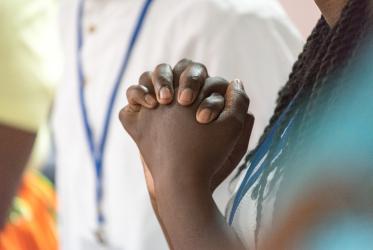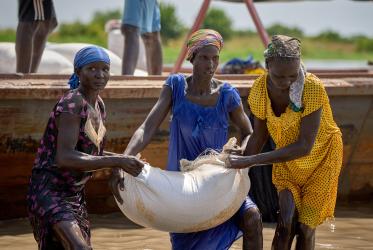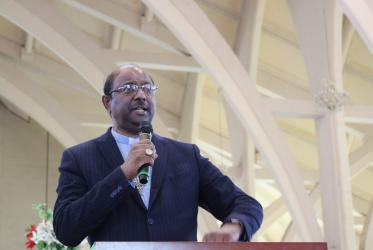A DISCUSSION PAPER: PERSONS WITH DISABILITIES AND GLOBALIZATION - THE CASE OF YOUTH WITH DISABILITIES
By Phitalis Were Masakhwe
Project Manager - Disability and Rehabilitation AMREF Kenya
Introduction
As the world shrinks into what is popularly referred to as the global village, it's becoming increasingly important to establish just where Persons with Disabilities fit into all this. This questions is vital especially for Persons with Disabilities in the Southern Hemisphere. More critical though, it is just how they can benefit from globalization. Sadly, the answers are not clear for Africans with Disabilities especially the youth. To benefit, is not enough for the climate to be right. It is imperative that they have access to the appropriate attire for various weather conditions the global arena presents.
Conditions for Youth with Disabilities
African youth with Disabilities conditions is fraught with many problems. By the way who are they? Is that man and woman who often times are hidden in rural areas. She/he is that creature you see begging in the cities and sometimes fighting with city askaris for space to sell their merchandise. She/he is those rags seated at the city street corners or moving, hands out stretched from motorist to motorist, thoroughly ignored by the public. She/he is the voice that struggles hard to be heard in high level decision making forums. He/she is the one often denied property ownership, even by their own parents.
Culture
The negative image of African Youth with Disabilities has its roots deep in African cultures. The negative attitudes, stereotypes and labels associated with disability can be situated in the African traditions and even Judo- Christian belief that disability is "Blemish". If there is dinosaur that needs pruning of irrelevant twigs is the African culture. Whenever it's convenient, there is a tendency to justify discrimination and other forms of oppression using African tradition and culture this will be seen, for instance with regard to access to education
Limited opportunities
Disabled youth, especially women with disabilities are lowly ranked in educational opportunities. Statistics from UNESCO states that only 6% of women have access to education and what kind of education and training opportunities are available to youth with Disabilities? Mainly secluded, under- funded and many times very poor quality education what of skills development? In developing countries especially Africa, few youths have the privilege of accessing quality and high level training opportunities. They are trained in less obscure, less regarded trades like shoe cobbling, manual tailoring and leather works, while non- disabled youths are training in computer engineering and nuclear physics. How can the world watch and allow this to happen in this age and era of information superhighway? What a contradiction! And did I hear somebody talk about equalization of opportunities? What a Joke?
Disabled youth also drop out of schools and colleges because of hostile social environment, inaccessible infrastructure and facilities. What does all this have to do with Persons with Disabilities and especially the youths position vis a vis globalization? A great deal.
We must understand where youth with disabilities stand in their own society before we can fathom their condition in the wider global society. In other words, if the youth with disabilities have to content with so many problems in their own country, they can only be expected to fair worse out there where they have to cope with numerous factors.
Situation and magnitude
According to rehabilitation international RI Africa has over 80 million People with Disabilities, about half of whom are youth with disabilities. Glonally the world has over 600 million people with disabilities, 40% of which are youth with disabilities. For the African youth with disabilities, the global village seems to be a mirage or an illusive spring of water.
To begin with, the rural youth lacks, not only the tools but also the necessary training to take advantage of this spring. An unfortunate situation presents itself with regard to the poor urban youth with disabilities. In most cases, they are uneducated, semi - skilled, constantly in search of a means of survival for themselves, their children and even their families!
Africans with Disabilities, especially the youth are generally handicapped when it comes to accessing the international market as business people. To engage in business at this level, one needs a significant outlay of money as capital.
Poverty as an obstacle
However, the World Bank and UNDP studies are telling us that in every six absolutely poor people, one of them has noe form of disability or the other; this will mean that disabled persons, more specifically the youths have difficulties meeting basic needs leave alone accumulating surplus funds that will be needed as capital.
It was noted above how discriminatory customs and services bar disabled youths especially women from inheriting property. Lack of property means disabled youth cannot use banks as alternatives.
For some decades now, the global labour market hs been recruiting, not on the basis of citizenship but on qualifications, competence and suitability to the particular job. In this particular market, youth with disabilities are victims of disability- related discrimination but more importantly, of what was referred earlier in terms of lack of quality and relevant education, type and nature of trainings accessible to them.
Access to information
The other critical question to observe is the issue of exposure to opportunities available in this global maze. Many disabled persons do not have acess to a simple transistor radio; leave alone a T.V, computer or the so-called websites. And even where information is available, in what format? Is it accessible to all persons with various communication needs? And at what cost? So where does this leave him/her in terms of information and the critical linkages to the global super highway? Of course owing to their history, up bringing and economic standing, many disabled persons are not highly travelled and exposed to have a deeper insight into the intricacies of globalization and attendant opportunities.
It will appear then that disabled persons, especially youth with disabilities cannot afford to take globalization for-granted. Though the global village is fertile with opportunities, which could help uplift them from contemporary soci - economic challenges, there are numerous problems for them to overcome before they can gain access. We need pragmatic programmes and approaches like Community Based Rehabilitation(CBR) run by AMREF and a few other NGOs.
CBR works to eliminate community and societal stigma towards persons with disabilities and empowers parents and Disabled Persons' Organisations for self advocacy; but more importantly, engages governments, civil society organizations and development partners, the private sector and media to create a level playing ground and field for disability mainstreaming and empowerment of those with disabilities. It works to minimize social, institutional, policy and legal barriers that hamper and impede faster socio - economic and political growth and development of those with disabilities.
Conclusion
In my view disabled people are still invisible in their own villages and societies. It does appear that there is still a lot of unfinished business. The war therefore must start from there if they must move and become visible and equal partners in the global village.
Thank you.




